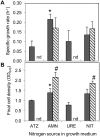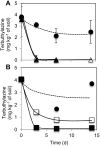Evaluation of Arthrobacter aurescens Strain TC1 as Bioaugmentation Bacterium in Soils Contaminated with the Herbicidal Substance Terbuthylazine
- PMID: 26662024
- PMCID: PMC4684385
- DOI: 10.1371/journal.pone.0144978
Evaluation of Arthrobacter aurescens Strain TC1 as Bioaugmentation Bacterium in Soils Contaminated with the Herbicidal Substance Terbuthylazine
Abstract
In the last years the chloro-s-triazine active substance terbuthylazine has been increasingly used as an herbicide and may leave residues in the environment which can be of concern. The present study aimed at developing a bioaugmentation tool based on the soil bacterium Arthrobacter aurescens strain TC1 for the remediation of terbuthylazine contaminated soils and at examining its efficacy for both soil and aquatic compartments. First, the feasibility of growing the bioaugmentation bacterium inocula on simple sole nitrogen sources (ammonium and nitrate) instead of atrazine, while still maintaining its efficiency to biodegrade terbuthylazine was shown. In sequence, the successful and quick (3 days) bioremediation efficacy of ammonium-grown A. aurescens TC1 cells was proven in a natural soil freshly spiked or four-months aged with commercial terbuthylazine at a dose 10× higher than the recommended in corn cultivation, to mimic spill situations. Ecotoxicity assessment of the soil eluates towards a freshwater microalga supported the effectiveness of the bioaugmentation tool. Obtained results highlight the potential to decontaminate soil while minimizing terbuthylazine from reaching aquatic compartments via the soil-water pathway. The usefulness of this bioaugmentation tool to provide rapid environment decontamination is particularly relevant in the event of accidental high herbicide contamination. Its limitations and advantages are discussed.
Conflict of interest statement
Figures





References
-
- EFSA (European Food Safety Authority). Conclusion on the peer review of the pesticide risk assessment of the active substance terbuthylazine. EFSA J. 2011; 9: 1969 Available: http://www.efsa.europa.eu/en/efsajournal/pub/1969 10.2903/j.efsa.2011.1969 - DOI
-
- PPDB (2013) General information for terbuthylazine Database: The Pesticide Properties DataBase, of the Agriculture and Environment Research Unit from University of Hertfordshire. Available: http://sitem.herts.ac.uk/aeru/ppdb/en/Reports/623.htm. Accessed 20 November 2014.
-
- USEPA (United States Environmental Protection Agency) (2011) Terbuthylazine final work plan registration review. Regulations.gov website. Available: http://www.regulations.gov/#!documentDetail;D=EPA-HQ-OPP-2010-0453-0005. Accessed 10 December 2014.
Publication types
MeSH terms
Substances
LinkOut - more resources
Full Text Sources
Other Literature Sources

